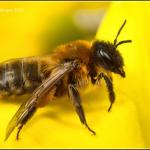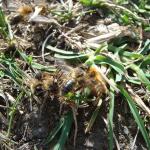One of the larger Andrena species, with a generally dark brown abdomen and contrasting orange hairs on the hind legs and thorax. This species is one of the first to emerge in the spring, males often flying rapidly over areas of bare ground or sitting on dandelion flowers. Since the mid-1990s however, an increasing number of confirmed records of freshly emerged specimens in July point to the presence of a partial (at least) second generation. Whether this has become possible with the increase in duration of higher temperatures for a longer period in our summer is a moot point. Westrich (1989) does not note this happening in southern Germany.
Over most of Britain, predominantly coastal in the west and extreme north. There are also scattered records for Ireland.
It is widely distributed in Europe.
This species is not regarded as scarce or threatened.
It occurs in a wide range of habitats.
April to June, with a small second generation in July and August.
Nests singly in short turf and bare ground.
It visits a wide variety of flowers for nectar.
Nomada goodeniana (Kirby) is a cleptoparasite on this species.
2016



